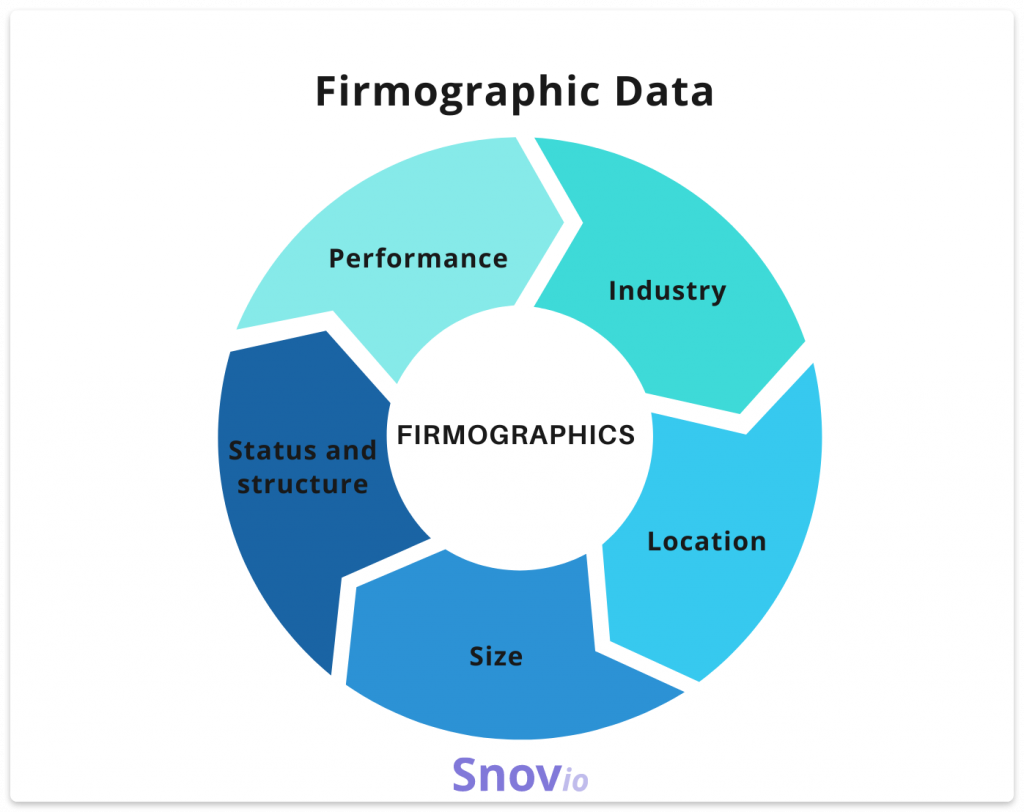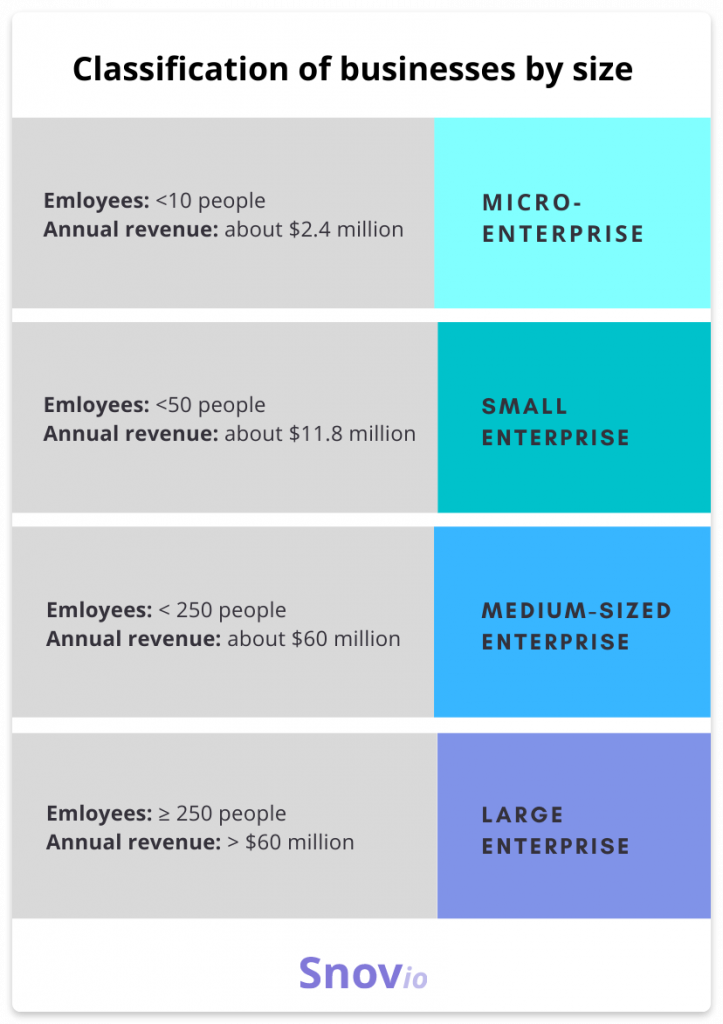Firmographics
Firmographics, or firmographic data, are characteristics of a company, such as its revenue, industry, number of employees, location, etc., that are used by businesses to segment their target market and pinpoint the ideal customers.

Firmographic data in detail
Let’s look through the main firmographic data businesses use as variables in their marketing segmentation.
Industry
Most companies are naturally constrained to certain industries due to their core product or the customers’ demands. Thus, the industry is a common category for segmenting the market. It’s reasonable to put companies that offer similar products to the same group. This allows businesses to adjust their campaigns to the needs of companies within the specific industry.
As a result, instead of building communication with different organizations across all industries, a company can narrow its targeting, increasing its chances of getting more conversions.
Location
Location firmographics presuppose categorizing organizations based on where they are situated. As such, companies may be segmented according to such variables as a city, state, region, and so on.
Yes, e-commerce grows rapidly, and e-retail sales are expected to reach 22% of all retail sales worldwide in 2023. But the geographic location shouldn’t be considered a blurred variable for segmentation. For many companies, proximity to the customer still determines the likelihood of a purchase. For example, climate may play a significant role in a particular business’s interest.
Segmenting the market by the companies’ location allows organizations to see in which geographical regions their marketing campaign is the most successful and to which regions they should dedicate more time and effort.
Size
Size firmographics define how big the business is. It’s clear that the marketing campaign addressed to small businesses won’t be as effective when directed toward a large enterprise-level company. That is why successful organizations segment customers according to their size.
The most typical indicators of the size of a business are its revenue and the number of employees. According to these two parameters, enterprises are classified into:
- Micro-companies
- Small companies
- Medium-sized companies
- Large companies
You may find various classifications. Let’s take a look at one of them:

Take into account that grouping companies by the number of employees vs. annual revenue brings different results. So, the more specific segmentation will be, the more closely it will match a company’s marketing and sales goals.
Status or structure
Such firmographic data as status or structure is about the relation of one company to another, or the legal status of the organization. For example, individual firms may be categorized as:
- Independent businesses
- Subsidiaries of larger companies
- Standalone entities
- Franchises of franchising companies
- Limited liability corporations
- Partnerships
- Privately-owned companies
- Publicly-owned companies
If you know for which type of organizations your product or service is of the biggest value, you can significantly increase the effectiveness of your sales and marketing campaigns.
Performance
The company’s profits and losses can indicate that it may need your product or service. So, grouping organizations according to these criteria can help make your marketing and sales campaigns real success.
Once you segment your list by the above-mentioned firmographic data, you will be able to develop your ideal customer profiles. In other words, you’ll identify those businesses to which you will direct your targeted marketing efforts and sales campaigns via various communication channels.
Firmographics vs. demographics
Both firmographics and demographics are used to build ideal customer profiles. The difference between these terms is that demographics are used to segment consumers, while firmographics are applied to target other businesses representing potential clients. In short, demographics are concerned with people, while firmographics are related to organizations.
Demographic data includes:
- Gender
- Age
- Profession
- Income
- Family status and structure (married/single, kids/no kids, etc.)
And here are firmographic data examples:
- Industry
- Location
- Size
- Status or structure
- Performance

Why use firmographics
Using firmographic segmentation in your business can bring many benefits. Here are several reasons this is a great idea:
- It reveals business insights into B2B marketing. Firmographics help answer such questions as what companies exist in the market, what products they launch, where they are located, and so on.
- It helps understand trends. Evaluating firmographic information, your business can recognize trends in data, which will help you build your marketing strategy.
- It enables you to save money. Implementing firmographics into your marketing process is a relatively low cost, so you can reach set marketing goals without having to invest tons of money.
- It saves your time for better leads. Indeed, you will spend some time analyzing your metrics in the beginning. But in the long run, using firmographics will allow you not to waste hours on ineffective leads. Instead, you will focus your time and effort on more qualified prospects.
- It helps you better engage your customers. 84% of clients say that being treated like a human is the key to making a deal. Firmographics will help you develop a more personalized approach to your customers, which will allow you to gain their attention.
- It helps you retain your clients. Understanding what types of businesses purchase your product or service allows you to predict their buying behavior. You can then suggest other solutions that may cater to the needs of certain customers.
- It keeps you from losing opportunities. Supporting your marketing and sales strategies by firmographic data reduces the risk of missing out on opportunities. It will allow you to see the scope of the market and find your potential customers.
- It boosts your marketing ROI and sales. All the factors mentioned above make up another reason for using firmographics for your business. In particular, it will help you come up with an effective marketing strategy aligned with your sales efforts. This will increase your sales and revenue.

Wrapping up
Firmographics are a great way to segment your prospective businesses based on similar attributes and make your targeting narrower and more efficient. Instead of the one-fit-for-all approach, you will be able to offer companies what they need, which, as a result, will bring you higher ROI and increase your sales.
If you still feel this path is too complex to try, Snov.io will help you segment your potential and existing customers around firmographic variables you’ll consider necessary.















